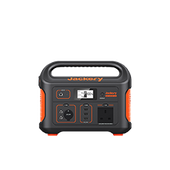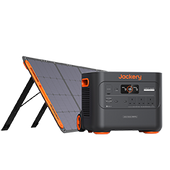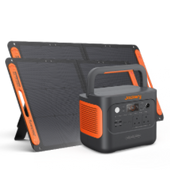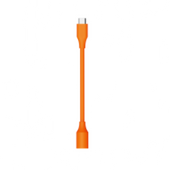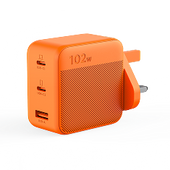With UK electricity prices continuing to rise and not expected to fall shortly, achieving energy independence is becoming increasingly desirable. An off-grid solar system will let you disconnect entirely from grid electricity and enable you to produce, store and deliver renewable energy.
Off-grid solar systems are an attractive way to achieve energy self-sufficiency, reduce carbon emissions and save money in the long term. This article will examine what an off-grid solar system is, how it works, its pros and cons, its components, and how to size it.
Besides, we highly recommend Jackery Solar Generator for those who want to use solar energy but have a limited budget. It combines Jackery Solar Panels with a Portable Power Station to turn sunlight into electricity and charge appliances effectively.
|
Key Takeaways: |
|
An off-grid solar system works by converting the sun's energy into electricity through the cooperation of solar panels, solar charge controllers, inverters and batteries. Choosing an off-grid solar system requires carefully examining its pros and cons. It is essential to understand how to size an off-grid solar system. We highly recommend Jackery Solar Generator 1000 v2 and 2000 Plus for off-grid living. The cost of an off-grid solar system depends on your equipment, the capacity required and the labour costs. |
What Is An Off-Grid Solar System?
An off-grid solar system gives you the freedom to live comfortably and have the option to run almost all of your appliances, rain or shine, morning or night.
An off-grid solar system is a complete system that contains everything you need to generate your electricity. It harvests energy from the sun and its rays through solar panels usually mounted on a home, cabin or RV roof.
An off-grid solar system uses sun energy to power a home, off-grid building, or recreational vehicle. Unlike a grid-connected solar system, an off-grid solar system has no connection to the grid, and its batteries store any solar energy collected from the solar panels to power parts or the entire home. In other words, an off-grid solar system is a solution for generating, storing, and using renewable energy.
How Does An Off-Grid Solar System Work?
If you choose an off-grid solar power system, you are parting ways with the power supply from the utility company. An off-grid solar system must be appropriately designed to generate enough electricity year-round, even in the depths of winter when sunlight is typically less. So, many people must wonder how an off-grid solar system works.
An off-grid solar system works by converting solar energy into electricity through the cooperation of solar panels, solar charge controllers, inverters, and batteries.
Step 1: The solar panel is the core of the off-grid solar system power generation. When solar radiation hits the solar panel, free electrons are released.
Step 2: The solar charge controller converts the energy generated by these solar panels into electrical energy and stores it in the battery.
Step 3: The battery stores the generated electricity in chemical energy, which can fully power the home even at night or when the sunlight is less than ideal.
Step 4: Since most electronic devices in the home use alternating current or AC power, you need to add an inverter to the solar power system components. With the help of an inverter, the DC power is converted into AC power, which is used to power electrical appliances and devices. So you can plug your appliances and electronic devices directly into the power sockets in your home.
The following figure is a schematic diagram of the working principle of the off-grid solar system:

Components of An Off-Grid Solar System
An off-grid solar power system mainly includes solar panels, charge controllers, inverters, and batteries.
- Solar Panels
Solar panels convert solar into usable electricity. Several types of solar panel mounting exist, including ground-mounted and roof-mounted systems. Ground-mounted systems are generally better suited for larger homes with ample space, while roof-mounted systems are better suited for homes with limited space.
There are three prime types of solar panels.
|
Solar Panel Types |
Monocrystalline Solar Panels |
Polycrystalline Solar Panels |
Thin-film Solar Panels |
|
Power Output |
High |
Medium |
Medium to low |
|
Efficiency |
15%-25% |
13%-18% |
7%-18% |
|
Cost |
Most expensive |
Relatively cheap |
Cheapest |
Solar cells come in various types, including monocrystalline, polycrystalline, and thin film. Each type has different efficiency levels and physical properties. Monocrystalline solar panels generally have a lower temperature coefficient, so they can maintain higher efficiency when it's hot outside.
Polycrystalline solar panels rarely exceed 17% efficiency and tend to be less powerful. They also tend to take up more space than monocrystalline panels. Thin-film solar panels' efficiency varies depending on the specific materials used in the cell, but they tend to be around 11% efficient.
- Solar Charge Controllers
The primary role of a solar charge controller is to prevent overcharging by controlling the rate at which current is added to or drawn from the battery. In simple terms, a solar charge controller helps extend the life of the battery and ensure the overall efficiency and safety of the solar system.
- Inverter
The inverter is responsible for transforming the DC power into the AC power most household appliances use. Different sizes of inverters can accommodate different power loads, so you need to choose an option that meets the requirements of your off-grid load.
Also, when selecting an inverter, ensure its continuous power and peak/surge power ratings (measured in watts) exceed your power needs.
- Batteries
Batteries are essential in off-grid solar systems because they store excess energy. The electricity stored by the battery can be used when the sun is not sufficient, ensuring a stable power supply.
There are two primary battery chemistries used to store solar power:
|
|
Lead-Acid Batteries |
Lithium Batteries |
|
Features |
Economical Maintenance required Ventilation critical Dangerous off-gassing can occur |
Higher upfront cost Maintenance-free Very safe Can be fully discharged to 100% of its rated capacity Cycles can reach thousands of times Built-in battery management system as a protection against over-discharge |
Lithium batteries are typically considered more economical than lead-acid batteries in the long run despite their higher initial purchase cost.
- Expense: Lead-acid batteries are typically more affordable initially; however, lithium batteries tend to have a longer lifespan and necessitate less maintenance, thus compensating for their elevated upfront expense.
- Lifespan: Lithium batteries have a lifespan of 5 to 15 years, whereas lead-acid batteries generally last 3 to 7 years.
- Maintenance: Lithium batteries necessitate minimal maintenance, whereas lead-acid batteries demand routine maintenance inspections, such as replenishing electrolyte levels and performing equalisation charging.
- Security: Lithium batteries incorporate inherent safety mechanisms, such as thermal protection circuits, to avert overheating.
- Implementation: Lithium batteries can be inserted in any orientation; however, lead-acid batteries must not be installed inverted.
Pros & Cons of An Off-Grid Solar System
Choosing an off-grid solar system requires carefully examining its pros and cons. While off-grid solar systems offer advantages such as low cost and energy independence, they also present challenges such as high upfront costs and complex systems.

Pros of Off-grid Solar Systems:
Off-grid solar systems offer numerous benefits to individuals seeking sustainable energy solutions.
- Energy Independence: Off-grid solar systems provide self-sufficiency, removing reliance on centralised grids and traditional energy sources. Off-grid solar systems are particularly beneficial in remote areas or places with limited grid access, as they provide a reliable power source without conventional infrastructure.
- Reduced Electricity Costs: Off-grid solar systems free you from being tied to national grid prices. Once installed, the ongoing costs of off-grid solar systems are meagre compared to relying on grid electricity, resulting in long-term financial benefits.
- Increased Property Value: Off-grid solar systems can enhance the value of your property, as many buyers today are increasingly looking to own energy-efficient and sustainable homes.
- Enhanced Environmental Benefits: Off-grid solar systems are renewable, creating a cleaner environment.
Cons of Off-grid Solar Systems:
The advantages of off-grid solar systems attract more people to choose them. However, there are also challenges when adopting an off-grid solar system.
- High Initial Cost: The upfront cost of purchasing and installing an off-grid solar system can be higher than a grid-connected system.
- Limited Power Generation: Off-grid solar systems may need to consistently generate more electricity, especially during periods of less sunlight or in areas with limited solar exposure.
- Large Space Requirements: Off-grid solar systems often require a lot of space to install solar panels, especially for homes designed to meet higher power needs.
- Higher Battery Maintenance Costs: Battery maintenance and regular replacement in off-grid solar systems can increase system maintenance costs.
What Size Off-Grid Solar System Do I Need?
Going off-grid means you will be 100% dependent on your electricity production and storage, so it is essential to understand how to size an off-grid solar system.
Sizing an off-grid solar system requires calculating the specific setup to generate, store, and deliver the electricity needed to power your home. You will need to determine the size of your solar system based on your expected electricity usage and available space.
This section will teach you how to size an off-grid solar system accurately.

Step 1: Evaluate Your Power Needs
To properly size an off-grid solar system, understand your home's electricity usage well. Please list all the devices you will be powering and record their wattage (usually on a label), including lights, fans, refrigerators, TVs, and laptops.
With your list of devices you will be powering, you can now calculate your daily electricity usage in kilowatt-hours. Multiply the wattage of the appliances you will be powered by the hours they are used daily and add them together to get your total electricity needs.
|
DC Appliances |
|||
|
Appliances |
Watts |
Daily Hours |
Watt-Hours |
|
Coffee Maker |
500W |
0.2H |
100Wh |
|
TV |
60W |
2H |
120Wh |
|
Fridge |
380W |
12H |
4,560Wh |
|
Light |
10W |
10H |
100Wh |
|
Total DC |
950W |
|
4880Wh |
|
AC Appliances |
|||
|
Appliances |
Watts |
Daily Hours |
Watt-Hours |
|
Phone Charger |
5W |
1H |
5Wh |
|
Laptop Charger |
10W |
5H |
50Wh |
|
Microwave |
700W |
0.1H |
70Wh |
|
Electric Drill |
300W |
1H |
300Wh |
|
Total AC |
1015W |
|
425Wh |
Step 2: Determine System Voltage
Choosing the correct battery voltage is critical for off-grid solar systems. You can typically choose from 12V, 24V, or 48V system voltages.
For small solar systems, 12V systems are a good choice for running lights, small equipment, and some low-power appliances. 24V systems are better suited for medium-sized installations or some large installations. 48V systems are ideal for large solar installations because they can manage a more significant power load with a smaller current.
Step 3: Determine System Battery Size
Batteries store solar energy for when it is needed, and their capacity depends on the amount of backup power required for appliances. Consider efficiency losses during charging and discharging when sizing batteries for off-grid solar. So, generally, you'll want to choose a battery bank larger than your power needs.
You should also determine how many days of backup you need if there is no sunlight (usually 2 to 5 days). Consider adding a backup generator in the winter to handle low sun conditions.
Step 4: Calculate Off-Grid Solar System Size
You can deduce the solar system size you will need based on your total electricity usage. However, you also need to know the production rate of your solar system. In the UK, the productivity of off-grid solar systems is an average of 3.225Wh per watt (W) per day.
Size of Off-Grid Solar System (kW) = Total Electricity Demand (kWh) / 3.225Wh
For example, if the total electricity demand is 32.25kWh, how big is the off-grid solar system?
Size of off-grid solar system (kW) = 32.25kWh / 3.225Wh
If the total electricity demand is 32.25kWh, the off-grid solar system is 10kW.
|
Solar Panel Watts |
Battery Size (Wh) |
Battery Capacity (Ah) |
|
100-175 |
600 |
50Ah / 12V DC |
|
200-350 |
1,200 |
100Ah / 12V DC 50Ah / 24V DC |
|
400-700 |
2,400 |
200Ah / 12V DC 100Ah / 24V DC |
|
800-1,400 |
4,800 |
400Ah / 12V DC 200Ah / 24V DC 100Ah / 48V DC |
|
2,000-3,000 |
9,600 |
800Ah / 12V DC 400Ah / 24V DC 200Ah / 48V DC |
|
4,000-6,000 |
19,200 |
800Ah / 24V DC 400Ah / 48V DC |
(Data Source: Unbound Solar)
Suppose you don't want to cost too much to install a solar system. Then, you can consider investing in a portable solar system, like Jackery Solar Generator, a combo of solar PV panels and a portable power station that you can use in your off-grid cabin or even outdoors when you work outside or camping.
Jackery Solar Generators for Off-Grid Living
Off-grid living is an excellent method to evade the congestion and frenetic pace of urban existence. Nonetheless, it is imperative to invest in appropriate equipment. Engineered for off-grid life, Jackery Solar Generators provide a dependable source of clean energy.
Jackery Solar Generators are comprised of SolarSaga Solar Panels for solar energy capture and Explorer Portable Power Stations for energy storage for further utilisation. The generator may supply power to numerous items, including but not limited to lighting, fridge, stove, and working tools.

Why do you select the Jackery Solar Generator for your off-grid lifestyle requirements? The Jackery Solar Generator is an environmentally sustainable and highly efficient power source for adventurers, capable of converting optimal solar energy into electricity.
Furthermore, the generator is user-friendly and necessitates minimal maintenance, rendering it a dependable option for off-grid living.
|
Off-Grid Appliances |
Solar Generator 1000 v2 |
Solar Generator 2000 Plus |
|
Fridge (350W) |
2.9H |
4.7H |
|
Lighting (25W) |
40.3H |
65.3H |
|
TV (60W) |
16.8H |
27.7H |
|
Phone (10W) |
100.8H |
163H |
|
Coffee Maker (550W) |
1.8H |
3H |
|
Stove (750W) |
1.3H |
2.2H |
|
Kettle (800W) |
1.1H |
2H |
Jackery Solar Generator 1000 v2
The Jackery Solar Generator 1000 v2 is an upgraded version which is smaller, lighter, and even more robust for off-grid living in the UK. It is the combination of Explorer 1000 v2 with SolarSaga 100W solar panel.
The Explorer 1000 v2 Portable Power Station has an impressive 1500W power output, over 50% more than earlier models, allowing for easy operation of high-demand appliances such as kettles, refrigerators and portable air conditioners.
Equipped with USB-A/C connections and capacity for up to 100W dual PD charging, this gadget can simultaneously charge many devices, making it the ideal companion for all your power requirements.
The Emergency Charge Mode, activated via the application, enables the Explorer 1000 v2 Portable Power Station to achieve complete charging in under one hour, providing essential power backup during battery depletion. Furthermore, the ability to charge from 0% to 100% within a two-hour timeframe utilising an AC wall outlet prolongs the battery's lifespan.

Jackery Solar Generator 2000 Plus
Jackery has unveiled the Solar Generator 2000 Plus, a cutting-edge portable power solution with exceptional performance. Thanks to its substantial capacity and formidable power output, this device can sustain the operation of standard domestic appliances for several weeks and fulfil all the power needs associated with outdoor adventure or professional activity.
The Jackery Solar Generator 2000 Plus allows adding extra battery packs, which boosts the capacity from 2 kWh to a remarkable 12 kWh, thus enhancing the solar charging capabilities significantly. With the ability to be expanded to 3000W, this solar product offers a 30% higher rated power than other 2 kWh solar goods available in the market.
The Explorer 2000 Plus is an industry's pioneering add-on battery pack that can be recharged using solar panels. This feature enhances versatility, improves charging efficiency, and reduces charging time. The LiFePO4 battery, with its sophisticated technology, guarantees a lifespan of 10 years, even with daily usage limited to once per day.

Average Off-Grid Solar System Cost in The UK
How much does installing an off-grid solar system cost in the UK? Generally speaking, the cost of an off-grid solar system depends on your equipment, the capacity required, and labour costs.
While the actual cost of an off-grid solar system varies depending on the application, some approximate figures can help you decide which system is better suited to your power needs. Understanding the costs of off-grid solar systems is critical to making the best decision.
Advances in solar technology have made it possible to purchase reliable and affordable systems, providing a sustainable and beneficial lifestyle choice for off-grid living. In 2024, the average off-grid solar system in the UK will typically cost between £2,500 and £10,500, including supply and installation. The most common off-grid solar system is the 4 kilowatt (kW) size, which costs around £5,000 - £6,000.
Here are the current costs of different sizes of off-grid solar systems in the UK:
|
Off-Grid Houses |
System Size |
Number of Panels (350W) |
Estimated Cost (Include installation) |
|
1-2 |
3kW |
8 |
£4,500 - £5,500 |
|
2-3 |
4kW |
10 |
£5,000 - £6,000 |
|
2-3 |
5kW |
13 |
£7,500 - £8,500 |
|
4-5 |
6kW |
16 |
£9,500 - £10,500 |
Factors impacting the cost of an off-grid solar system in the UK:
- The size of the solar system
- The type of solar panel
- The type of solar cell
- The size, area and shape of the roof
- The location of the property where the solar system is installed
- Government subsidies or tax breaks for solar systems
Is Off-Grid Solar System Worth It?
Many people need clarification about whether buying an off-grid solar system in the UK is worth buying. Whether it is worth purchasing an off-grid solar system in the UK depends on many factors. So consider the following points before choosing: electricity prices, electricity demand, amount of sunshine in your area, budget, and environmental impact.

Despite the recent global chip shortage and the pandemic, solar hardware prices have not changed much since 2020. Meanwhile, energy companies have been jacking up prices recently, making record profits.
Moreover, considering the recent energy pricing in the UK, many people can easily decide to go with an off-grid solar system. Even if you don't live entirely off the grid, installing a smaller 4 to 6-kW solar system can significantly reduce your electricity bills in the long term.
Overall, it is worth installing an off-grid solar system at the moment. Not only is it a break-even proposition, but it also contributes to the health of the planet and the stability of the larger grid.
Off-Grid Solar System in The UK FAQs
The following are the frequently asked questions about the off-grid solar system in the UK:
- Who is an off-grid solar system suitable for?
Off-grid solar systems are often used in places far from the grid, such as individuals, businesses or communities in rural or remote areas. Because these areas need reliable grid connections or because the cost of a grid connection is too high.
- Which is better, an off-grid or grid-connected solar system?
Which is better, a grid-connected or off-grid solar system? It is not absolute. The most significant disadvantage of grid-connected systems is that they cannot protect you from power outages on the grid. Still, they can provide power when solar power generation is insufficient to meet your needs.
Rural areas may benefit more from off-grid systems than grid-connected systems because power supply in these areas is often less reliable or non-existent. So, choosing an off-grid or grid-connected solar system depends on your personal needs and where you live.
- Is an off-grid solar system feasible without batteries?
It is feasible to have an off-grid solar system without batteries. However, batteries are essential to store the excess energy solar panels generate. Without batteries, it will be a challenge to maintain a stable power supply. There is a high chance of facing challenges and difficulties when running out of power at night or on cloudy days.
- Are off-grid solar systems high maintenance?
Off-grid solar systems are low maintenance compared to other power generation systems. They are excellent for those seeking sustainable, cost-effective, and reliable energy.
Final Thoughts
Switching to an off-grid solar system has become an increasingly attractive option for many people in the UK to achieve self-sufficiency. You can enjoy sustainable electricity for many years by investing in the right off-grid solar system. While there are challenges, such as weather-dependent electricity production and initial costs, the benefits of energy independence and environmental impact far outweigh these considerations.







